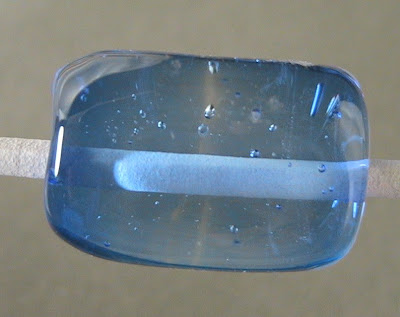
CiM Stone Ground was designed to be an equivalent to the Effetre Opal Yellow. How does it stack up in head-to-head testing?
Well - the unworked rods look a little different from each other. That's the CiM on the left and the Opal Yellow on the right. Opal Yellow is something of a misnomer, btw - if you are looking for a yellow glass - it is more of dark ivory colour. It has varied quite a bit from batch to batch over the years - this particular lot is thicker and has very definite layers on the cut ends. The Stone

Ground also displays rings, like growth rings in a tree. Some of the rods are a slightly different shade - but just laying there, cold - the Stone Ground looks stonier, and and slightly greyer and greener.
So - do they work the same? I would say: "pretty darn similar!"

Here we have the Stone Ground on the left in the smaller bead, and the Opal Yellow on the right in the slightly larger bead. It appears lighter in colour, but I'm not altogether convinced that is not the result of it being heated last and not striking as long. The decorative blobs are Double Helix Triton, which were then reduced. It does seem to have reacted to a darker line on the Opal Yellow.

This bead is a base bead of CiM Stone Ground on the left - to the middle, and Opal Yellow on the right.
The bead was rolled in silver foil, melted in, reduced. Dots of light ivory. Then mashed. Then oxidized. That's when the little white dots appear on the larger, light ivory dots.
The two rows of dots on the right end of the bead appear quite different - more of a copper green colour - but I'm reasonably sure that the row of dots next to it is still on the Opal Yellow.

The other side is a little more varied in pattern The whitish rings pop up on the light ivory dots on top of melted in silver when you turn UP the oxygen (or the gas down). It takes awhile - 2-3 minutes, of gentle surface heat for them to happen (which is why they are only partially formed - I got bored. )
The Opal Yellow is softer than the Stone Ground - tends to lose it's shape more. I spent more time re-shaping the Opal Yellow side of the bead.

This bead with the pinkish spots is a base of clear (simply to conserve the more expensive glass). There is the Stone Ground encased onto the clear on the left, and Opal Yellow on the right. I did large dots of EDP (Evil Devitrifying Purple, Effetre 254 - Purple), alternated with small dots of Copper Green. Both colours of dots got small dots of Light Turquoise on top. The EDP bleeds out into the Stone Ground and the Opal Yellow in a most satisfactory manner. The Copper Green and EDP have pushed the Opal Yellow around like crazy - forming excellent lines of delineation. The de-vit from the EDP seems to have spread to the Stone Ground a bit more than the Opal Yellow.

This final bead is a base of clear (for economic reasons), encased with Copper Green, rolled in silver foil, melted in. The dots on the RIGHT this time are the Stone Ground, and the dots on the left are the Opal Yellow. Both dots have EDP dots on top. Again, the Opal Yellow looks a little lighter.
BTW - that copper green with the foil looks awesome!
It might be a fair generalization to say that the Opal Yellow tends to look a little lighter. In terms of reactivity and "cool effects" - both of them react strongly - the Stone Ground possibly more so - perhaps just as it is a little darker.
I'd say they are pretty comparable.

 This is CiM 921 - Blush
This is CiM 921 - Blush










































